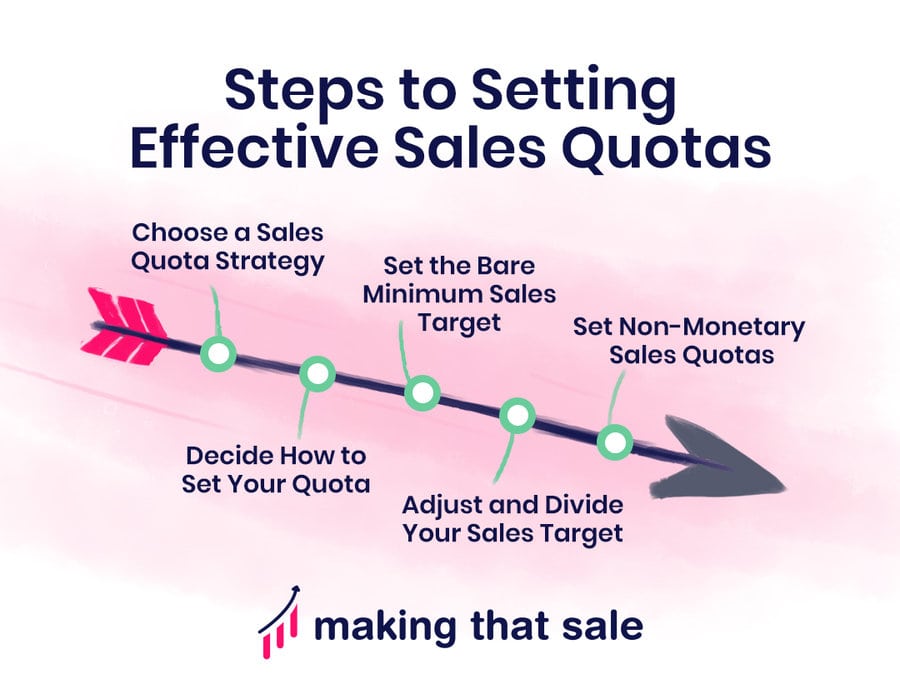Is there such a thing as “ethics” in sales? If you’ve found yourself asking, “What is ethical selling?” you’re not alone.Alt ...
How to Set a Sales Quota
Written by: Victoria Yu
Victoria Yu is a Business Writer with expertise in Business Organization, Marketing, and Sales, holding a Bachelor’s Degree in Business Administration from the University of California, Irvine’s Paul Merage School of Business.
Edited by: Sallie Middlebrook
Sallie, holding a Ph.D. from Walden University, is an experienced writing coach and editor with a background in marketing. She has served roles in corporate communications and taught at institutions like the University of Florida.
Updated on November 30, 2023

How to Set a Sales Quota
- Why Is Setting a Sales Quota Important?
- Six Sales Quota Strategies
- How to Set a Sales Quota
- Conclusion
Sales is the beating heart of a company, pumping cash like blood: the company needs a consistent supply to stay alive. The more active the business becomes, the more sales revenue it needs to support the extra exertion.
Though your sales team might try their best to make as many sales as possible, how will they know if they’ve done enough? The answer to this is to set a sales quota.
If you’ve been struggling to set a sales quota that perfectly balances your team’s capabilities with your company’s needs, we’ve got you covered. This guide will walk you through all you need to know about how to set a sales quota that will drive your company and sales reps to success.
Key Takeaways
A sales quota is a sales goal for an individual sales rep, telling them how many sales they need to close or sales-related activities they need to complete in a given time period.
An effective sales quota ensures the company is making enough sales to sustain itself and meet its growth goals.
There are six types of sales quota strategies: volume quotas, revenue quotas, profit quotas, activity quotas, forecast quotas, and combination quotas.
To determine your sales quota, first choose a sales quota strategy, decide on a top-down or bottom-up approach, determine the bare minimum sales target, adjust and divide the sales target into individual sales quotas, and convert your sales quota into activity quotas.
Why Is Setting a Sales Quota Important?
A sales quota is a short-term goal describing how many sales you expect each rep to make within a certain period of time (usually per month or per quarter). But why do you have to set sales quotas in the first place? Can’t you just tell reps to make as many sales as possible? And why can’t you just keep pace with your competitor?
To answer these questions, here are four reasons why it’s important for sales managers to learn how to set their own sales quotas.
Sales Quotas Set Cash Flows
If you set your sales quota too low or your sales team underperforms, your company might suddenly find itself without the cash to cover expenses and wages and go into debt. In the worst-case scenario, the company may even go bankrupt.
On the other hand, if sales reps doggedly make as many sales as humanly possible, they might promise more than your company can deliver or oversaturate the market too quickly.
Sales Quotas Are Unique
Every product, company, and sales department is different, so you can’t copy a sales quota figure from a competitor or business partner. So how do you determine what’s a reasonable sales goal to strive for, and what’s a pipe dream number? Setting a proper sales quota can mean the difference between underachieving, keeping pace with competitors, or burning out your sales reps. That’s why business leaders should take care when setting sales quotas.
Though some may say that sales reps should simply try to make as many sales as possible, this laissez-faire attitude may cause your sales team to unpredictably underperform or recklessly overperform. Both of these situations will cause issues for your business.
Sales Quotas Hold Sales Representatives Accountable
Setting sales quotas holds each rep accountable for pulling their own weight in the team, makes sales management easier, and helps company decision-makers plan the company’s strategy in more detail.
Managers usually set punishments for not meeting quotas, and/or bonuses for exceeding them.
Thus, it’s in everyone’s best interest for sales leaders to decisively set accurate sales quotas that are achievable, so everyone can be satisfied with their job and pay.
Sales Quotas Keep Reps Ethical
Sales reps who are pressured to meet unrealistic sales quotas may resort to unethical tactics to inflate their metrics, or may burn themselves out from exhaustion. A sales quota gives them a suggested stopping point where reps can take a break and feel satisfied with their work.
Six Sales Quota Strategies
Before you can get started setting your own tailored sales quota figure, it’s important to determine how you’re measuring your sales quota — in other words, your sales quota strategy. While it may be easy for some companies to set quotas based on the number of products sold, some other companies that focus on, say, customer retention and lifetime value would have to find another way to measure sales rep activity.
With that in mind, there are six different sales quota strategies you could choose from. Let’s take a look at each one, and discuss when it might be wise to implement each strategy.
1. Volume Quota
The simplest and most popular type of sales quota is a volume-based sales quota, where sales reps are tasked with selling a certain number of product units per period.
A volume quota is best for companies with only a few products for sale whose prices are fixed, and whose sales cycles don’t take long to complete – say for example, a clothing boutique or hot dog stand. Additionally, companies can use volume-based quotas strategically to promote one product over another by setting the volume quota for one item higher.
2. Revenue Quota
A revenue-based sales quota sets a discrete dollar amount that each rep must bring in during the time period, regardless of what product or how many units they sell.
A revenue quota is best for companies that sell a wider range of products at different price points, such as a furniture store. Sales reps will have the freedom to choose between selling many low-priced items or only a few high-priced items, flexibly mixing and matching according to their customers’ needs.
3. Profit Quota
A profit-based quota is similar to a revenue-based quota, but is based on the gross margin of each sale – in other words, the revenue minus the cost brought in from each deal.
A profit quota is best for sales departments where sales reps have a little more flexibility in negotiating prices and deal scope with the client, such as a car dealership. In those cases, there’s no guarantee that the revenue generated from each sale they close will outweigh the cost of fulfilling the negotiated order. A profit-based quota deters reps from handing out too many concessions and making unprofitable deals.
4. Activity Quota
An activity-based sales quota requires salespeople to complete a set number of activities during the time period, such as making a certain number of phone calls, sending a certain number of emails, and scheduling a certain number of appointments.
An activity quota is most useful for sales departments whose employees are specialized by function, such as sales development representatives (SDRs) who only generate new leads, account executives who only nurture and close sales, and account managers who only manage existing customers. In these cases, you would set a different activity quota for each job function that measures their specific responsibility in the sales process.
This strategy also works well for sales departments that make very few sales overall, but build customer value through nurturing communications and customer lifetime value.
5. Forecast Quota
A forecast-based sales quota takes the historical performance of a region, time period, or sales team, and uses forecasting to predict how much revenue sales reps can expect to make.
For example, if your company sells ice skates, your sales forecast would be much higher in a more northern sales territory during the winter than in a more southern territory during the summer. Alternatively, the forecast for your most well-performing sales team would be much higher than the forecast for a newly-formed sales team of fresh hires.
A forecast quota is best when there’s a large variance in a company’s sales performance between territories, seasons, and sales teams, as it sets individual quotas based on the unique attributes of each area, time period, or team. This ensures that each group is judged according to their feasible ability.
6. Combination Quota
Finally, a combination quota mixes and matches elements from the previous five sales strategies, setting different quotas to best capture a sales team’s activities. For example, a manager could set both a volume-based and activity-based quota for sales reps by saying that they must sell a certain number of units and make a certain number of phone calls per sales period.
A combination quota is best for sales teams where salespeople complete a wide variety of tasks, all of which are of equal importance.
How to Set a Sales Quota
Now that you’re familiar with your strategy options, it’s time to decisively set your sales quota in five simple steps.

1. Choose a Sales Quota Strategy
The first step is to decide which of the six sales quota strategies that we outlined above would be most suited to your business model and sales department structure.
As we mentioned earlier, some factors that should be considered are:
- If your company sells only one product (favors a volume-based approach)
- If your company offers a large variety of products (favors a revenue-based approach)
- If your sales reps have extreme control over the product pricing and scope of each deal (favors a profit-based approach)
- If your salespeople have very specialized roles, or if your company focuses on customer lifetime value (favors an activity-based approach)
- If your sales territories, seasons, or teams are extremely varied (favors a forecast-based approach)
Your sales quota strategy will guide your sales reps’ activities and priorities, so it’s wise to choose something that matches your broader company goals and timeframe, such as if you’re hoping to make a lot of sales quickly or build customer loyalty in the long term.
If you find yourself caught between a whole host of considerations, then it may be worthwhile to set combination-based quotas perfectly tailored to your sales department’s needs.
2. Decide How to Set Your Quota
Next is to determine the methodology by which you’re going to set your sales quota. Your two options are a top-down approach and bottom-up approach.
Top-Down Approach
In a top-down approach, the sales leader works with decision-makers to set a company revenue objective for the period and splits that revenue objective into sales quotas for each rep.
For example, if your company wants to make $100,000 in a quarter and you have four sales reps, you would set a quota of $25,000 per sales rep.
While the top-down approach perfectly aligns your sales department with the company’s strategic plans and ensures that your sales department makes enough money to keep the company afloat, it doesn’t account for your sales team’s true capabilities. In other words, you risk setting a quota that’s impossible for your sales team to achieve, which sets your team up for frustration and disappointment on all fronts.
Bottom-Up Approach
On the other hand, with the bottom-up approach, the sales leader observes each rep’s historical performance and potential and assigns their sales quotas individually. For example, if you have two reps who made $30,000 and $20,000 last quarter, you would set their quotas at $30,000 and $20,000 again for this quarter.
While this increases the chance that each rep will meet or exceed their quota, this may also lead to a disconnect between your sales department’s activities and your company’s executive goals — your sales team might not be able to support the growth your decision-makers are looking for, or in the worst-case scenario, might not be able to meet your minimum sales target.
Despite this, most consultants and advisors recommend a bottom-up strategy, as it ultimately gives a more accurate forecast of your team’s sales in a given period rather than setting decision-makers up for disappointment. Plus, having more achievable goals improves sales rep performance and morale.
3. Set the Bare Minimum Sales Target
The next step is determining your bare minimum sales target, the break-even point that ensures your company has enough money to see another day.
Your sales target is the sum of all the sales quotas for individual reps — think of it as the sales quota for your company as a whole. As such, it should be determined based on your company’s historical data and on how much money it generates per month.
To calculate your monthly sales target, add up the last 12 months’ worth of revenue your sales department brought in and divide it by 12. Alternatively, you could multiply the average number of closed-won deals per period by your average contract value.
4. Adjust and Divide Your Sales Target
Now that you have your historical minimum sales target, it’s time to adjust and divide it for your current situation and your current team of sales reps.
First, adjust your department-wide sales target for market conditions such as expected inflation, supply chain issues, seasonal fluctuations, and new competitors. Then, tack on your company’s targeted revenue growth.
Divide up your sales target into sales quotas for your territories, sales teams, and individual salespeople, and make additional adjustments based on their unique traits and sales potential, such as how many leads are available in each region and your sales compensation plan.
5. Set Non-Monetary Sales Quotas
While sales managers using revenue-, profit-, or forecast-based sales quotas might be able to stop there, those with volume-, activity-, and combination-based sales quotas will have to take one last step to convert their dollar-value sales quota to their chosen non-monetary sales quota.
To convert to a volume-based quota, simply divide the total dollar amount of your sales quota by the price of each unit.
For activity-based quotas, decide on the activities and metrics that will best correlate with the sales quotas you set per sales rep. For example, if your historical data tells you that it takes an average of four phone calls before your sales rep can close a deal, you might set an activity quota of 40 phone calls per month for your sales reps in hopes that they make an average of 10 sales each.
Even if you don’t use an activity-based quota, we recommend setting activity guidelines for your reps to help guide their selling efforts. This would especially help your newer reps find their footing.
Conclusion
You might feel like Goldilocks as you try to find an effective sales quota that’s not too low to cause a deficit, but isn’t too high as to cause burnout. Unsustainable and unrealistic quotas cause stress and strain for the whole company, so it’s a good idea for business owners and sales leaders to learn about quota setting as quickly as possible.
Setting a sales quota can feel overwhelming, especially for people new to sales leadership. But by following these strategies and steps for setting a realistic sales quota, your sales organization will soon be meeting all its sales goals. Your reps and company decision-makers alike will be overjoyed by revenue and activity being not too high and not too low – but, instead, just right.
FAQs
While the three terms are related, they operate on increasingly smaller scales. The largest is the sales goal, which is the company’s long-term financial objective. Next is the sales target, which is the dollar revenue the sales department as a whole needs to make to meet the sales goal. Finally, a sales quota is the revenue or other sales metric that each individual rep needs to make to meet the team’s sales target.
For example, decision-makers could set a sales goal of increasing profits by 15% this year. A sales leader would then translate that into a concrete $300,000 sales target per year, or $25,000 per month. The sales leader would then divide the sales target into individual sales quotas of $7,000, $6,500, $5,500, and $6,000 for each of the company’s sales reps for that month.
Sales quotas are often tied to sales representative compensation to encourage salespeople to meet the quota. Some sales compensation plans that correlate to sales quotas are commission-only compensation plans, absolute commission plans, bonus plans, and gross margin commission plans.
Another key element of enforcing your sales quota is getting the buy-in from your sales team. If you’re implementing a sales quota for a team where there was none before or changing your quotas frequently, you should sit down with your sales reps and explain to them how you set the quota, walking them through the adjustments you made to arrive at your final numbers. Explain how their contributions will directly affect the company’s success to make them realize how their efforts serve a larger purpose.
A customer relationship management (CRM) platform can help you set and track sales quotas by tracking your company’s sales pipeline, rep-customer interactions, and the size of closed deals. Some vendors of CRM software are HubSpot CRM, Salesforce CRM, and Zoho CRM. Beyond the sales department, CRM tools can also help with marketing and customer service functions, so we’d recommend purchasing a CRM system as an all-in-one tool to help boost every element of your business operations.
Alternatively, if your company already has a CRM and has the budget for specialized sales and operations planning software, some providers you could look into are Anaplan, Workday, and Xactly. Additionally, as sales quotas are often tied to employee compensation, compensation software solutions like QuotaPath can also help track quota attainment.
Featured Resources

What is Ethical Selling?
Published on May 24, 2024
Read Now

What Is Thought Leadership?
Published on May 24, 2024
Are you looking for ways to stand out from the crowd and establish yourself as an expert in your field? Thought leadership might be just what younee ...
Read Now

Common Sales Objections and How to Address Them
Published on April 10, 2024
You know the drill. You’re deep into your pitch, and just as you’re about to close the deal, the client throws a curveball.“It’s ...
Read Now
